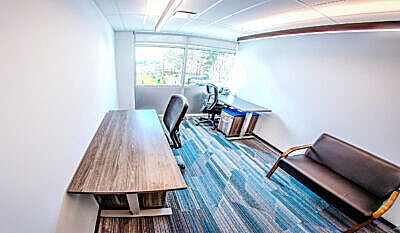Corporate office hours of 9 a.m. to 5 p.m., Monday through Friday, are rapidly disappearing. Even working from home full-time seems outdated. A flexible, hybrid economy supported by coworking spaces is the future of work.
The way we think about workplaces should change, just as the future of work also does. The traditional model of a required office for all employees is no longer practical, and coworking spaces will play a big role in the new dynamic work landscape.
Stay informed about the evolving nature of work and discover the benefits of incorporating coworking into your routine to stay competitive.
Future of Work
There’s no denying that the future of work is changing. Even before the global pandemic, there was a growing trend among companies that were starting to embrace remote work.
According to Global Workplace Analytics, in 2019, 5.7 million US employees worked remotely for at least half of their working hours. However, the same research estimates that 75 million US workers could work from home because they have jobs that are compatible with remote work.
Remote work is a popular trend, but it doesn’t end there. Work looks different today than ever before, with technology propelling us forward, the ever-growing gig economy, asynchronous collaboration tools, hybrid work structures, the popularity of coworking spaces, and the shift to a job seeker’s market.
Quiet Quitting
When workers “quiet quit,” they basically stop being motivated in their jobs and start doing the bare minimum. This is a recent term that blew up on TikTok earlier this year. This trend is being driven by several factors, including the increasing use of technology in the workplace, the rise of the gig economy, and changing attitudes about work/life balance.

For many people, working isn’t what it used to be. With more and more employers expecting employees to be available 24/7 thanks to technology like email and smartphones, workers are feeling increasingly burned out.
Advancing Technology
Technology is playing a key role in how work is changing. Automation, virtual assistants, and artificial intelligence have taken over many tasks that were previously done by people in offices.
Some jobs will soon be obsolete, while others will become more in demand as we rely on technology to do more. Others will still require a human touch but will evolve into more tech-enabled and tech-supported roles.
The Gig Economy
The gig economy is also on the rise, as more and more people are freelancing or working temporary jobs. Estimates show that the number of freelancers in the US will increase from 70.4 million in 2022 to 90.1 million by 2028.
Such significant growth is, in part, because there are now many more opportunities to work remotely or on a freelance or contract basis. With more companies willing to hire workers remotely, there’s no longer the constant need to be tied down to one location or one company.
All of these changes are making the traditional work model obsolete. We can’t continue to rely on a single office for a single company when work is flexible and, in most cases, can be done from nearly anywhere.

Asynchronous Collaboration
With the rise of remote work, asynchronous collaboration is also becoming more popular. Asynchronous collaboration is when team members work on their time rather than having to be online at the same time.
Instead of having a video call to discuss a project, team members can leave each other comments or questions in a shared place. Then, everyone can review the discussion and add their thoughts when it’s convenient for them. This allows each team member to productively allocate their time.
Asynchronous collaboration is more flexible and can be done from anywhere, which is perfect for a world where work is no longer tied to one specific location.
Hybrid is the New Normal
With all of these changes, it’s clear that the future of work is hybrid. While many jobs can be done from home or practically anywhere, some tasks, meetings, and jobs will still need to be done in person. This shift has already begun, and it will only become more evident in the coming years.
The rise of coworking spaces is also playing an important role in this shift. Coworking spaces are a fantastic solution for hybrid work. They provide a place to go when you need to be in person and offer the flexibility to work from home when you don’t.
Growth of Coworking
Work is becoming more hybrid, and coworking spaces offer a flexible solution for this new way of working.
Coworking spaces have already experienced sizable growth recently, which is only predicted to continue as more and more people embrace the hybrid model. In 2017, there were over 4,000 coworking spaces in the US. By 2022, that number had increased to over 6,200.
Employees who disliked working from home now have the option of a coworking space, which can get them out of the house without relying on a company-provided workspace.
It’s also a suitable option for self-employed or freelance workers who want a workspace outside of their homes or need to supplement their home offices with additional workspace or meeting rooms.
Shift to a Job Seekers’ Market
There has also been a shift to a job seekers’ market as a result of the Great Resignation, which saw workers leaving their jobs en masse due to toxic work culture, lack of flexibility, poor COVID response, and the possibility of finding a better, more flexible job.
Employers will need to provide more perks and benefits to attract and retain employees in a market where they are at a disadvantage.
The perks employees tend to look for include a hybrid or remote work structure, optional access to a coworking space, more time off or a flexible work schedule, better healthcare, and an improved work/life balance.
Why Coworking Is Important to the Future of Work
Coworking spaces are helping to support the future of work. First, they provide the perfect solution for hybrid work. Second, they’re already experiencing significant growth, and we expect this trend to persist. Finally, they offer employees perks and benefits that are becoming increasingly important in today’s job market.
Flexibility for Business and the Workforce
Coworking spaces are flexible, which is important for businesses that may not have the budget or space for a traditional office. It’s a great solution for businesses that want to hire for talent, not location, without limiting workers to their homes, where many people don’t have the space, resources, or privacy to work effectively from home.
Using coworking spaces also helps to save money because businesses don’t need to formalize offices in multiple locations but can still provide an office option for their workers who would prefer it.




They also offer employees the ability to work from home (WFH) when they need to but give them a place to go when WFH isn’t ideal. Workers today see flexibility as a need, not a want, and many won’t take a job (or would leave a job) that didn’t offer the option to work remotely some of the time.
It’s a common-ground solution between office work and homework because attendance isn’t required but optional, and it’s more formal and constructive than working from home can be at times.
Community-Driven Connection and Collaboration
In a coworking space, you’re surrounded by other people working on their projects, which can lead to serendipitous collaboration and connection. It’s the perfect environment for networking and building relationships with other professionals in your field.
Rather than collaboration and community connection solely through a job, people become better connected by the kind of work they do, where they live more generally, and the lifestyle they lead.
In coworking spaces, same-company coworkers can still work together, too. If a company hires a few remote workers all out of the same city, renting an office in a coworking space provides a way for the team to collaborate and connect in realtime.
Working from home can be lonely and isolating, and coworking spaces are communal and social places designed for work and connection. It gets workers out of their homes, gives them a reason to dress, and provides a place to focus on work.
A Source of Inspiration With Less Distraction
While working from home has its perks, it can also be distracting. It’s easy to get sidetracked by things like laundry, dishes, or other household members when you’re trying to focus on work.
It can be difficult to find a place to work at home that is both comfortable and inspiring. And if you do have a dedicated office space, it can be difficult to keep it feeling fresh.
Coworking spaces aim to foster inspiration and creativity, offering distinct areas to accommodate various working styles. For example, some people might prefer to work at a standing desk, while others might want to take advantage of the lounge area.




Filling in the Remote Work Gaps
Remote work is ideal for many people, but it can remove some of the perks that come along with more traditional office environments. Coworking spaces excel in bridging these gaps by offering valuable small “extras” and perks.
Socializing is one of the biggest things. It’s difficult to socialize when you work alone physically, and coworking spaces often house happy hours, mixers, and other events so you can mingle and connect with like-minded individuals.
Lastly, coworking spaces’ culture is crowd-sourced, so you can find the best place to work and thrive.













